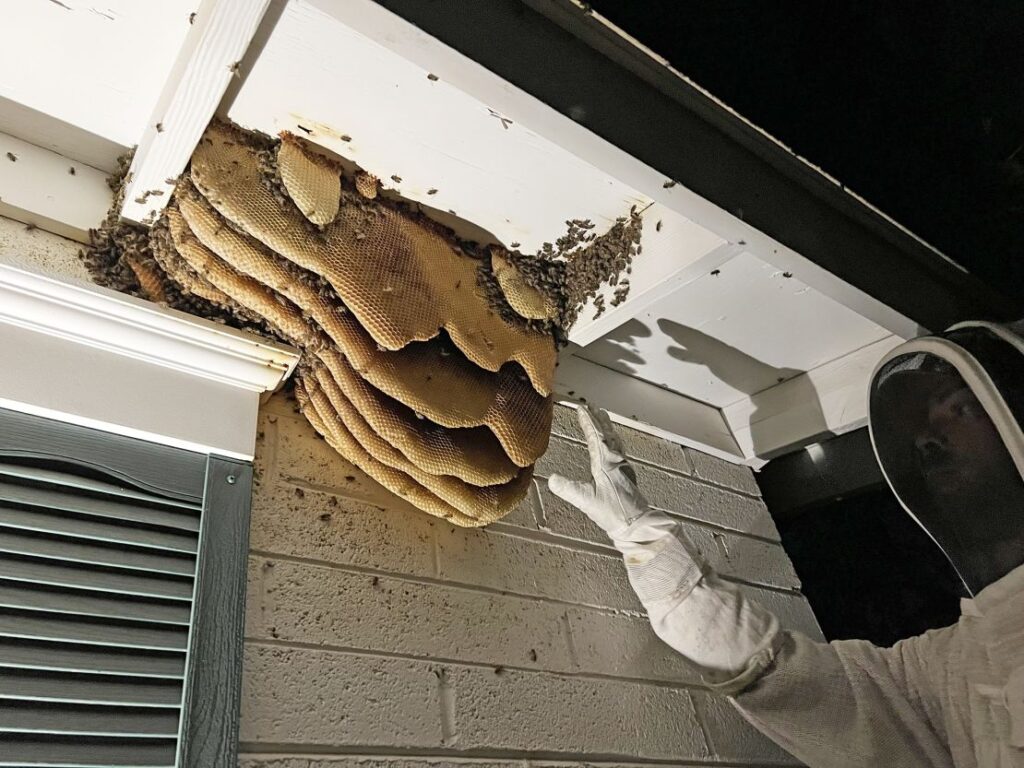We see Phoenix homeowners with unwanted residents in the most unexpected places on their property. The perfectly hidden bee havens established and left undetected for up to three months are one of the most familiar features of desert landscaping found across the Valley Block walls. Although the desert climate and ample flowering plants entice bees to Phoenix, those busy little creatures do not always select nearby locations to settle.
Bees that set up house in block wall cavities are just about sightless until the swarm becomes so big that they are problematic or dangerous to structures. If you think there are bees in your property’s block walls, you should call a removal service from Green Mango Pest Control to exterminate the bees safely.
Subtle Warning Signs of a Hidden Beehive
- Increased Bee Activity Near Wall Sections
Bee traffic around your block wall is one of the first signs of a concealed beehive. Bees fly through small cracks or weep holes, so you may see them entering and/or leaving when they are most active in the early morning and late afternoon.
- Sweet, Waxy Odors Coming from the Wall
During the hot summer months of Phoenix, when temperatures routinely climb above 110°F, this fragrance becomes more pronounced because the wax and honey seep into the air more.
- Dark Staining or Discoloration on Block Surfaces
Honey and wax can ooze through mortar joints and leave stains on the outside of your wall. After Arizona’s monsoon rains, these dark patches frequently bloom as streaks running down from where the colony is located.
- Unusual Buzzing Sounds from Within the Wall
When you suspect an active infestation, listen closely. You can sometimes hear a low hum or buzz from the inside of the walls. This sound is most evident on calming evenings when noise levels fall.
- Structural Cracks or Loose Mortar Joints
Over time, these large colonies can inflict physical damage on block walls. Phoenix building inspectors say around 15% of bees getting into houses is related to the structural concern of the block wall getting chewed out because the hive has taken up residence and not been treated.
Why Block Walls Are an Ideal Hiding Place for Bees
Bees have everything they need to ease into well-forged colonies in many Phoenix neighborhoods, where block walls abound. Regular concrete blocks, with hollow cores, also form large cavities that provide access for bees through small holes or broken mortar joints. These microhabitats are excellent insulators from extreme temperatures found in Arizona, keeping colonies cool during blistering hot summer days and warm during cool winter nights. Phoenix is replete with desert landscaping, allowing profuse nearby nectar resources (such as palo verde trees, desert willow, and songbirds with flowering plants in the yards). Phoenix experiences an urban heat island, which creates microclimates around block walls that many of the philopatric bee species exploit: the perfect real estate for colony development.
How Professional Removal Prevents Long-Term Damage and Recurring Nests
Thermal imaging is used in the first step to identify the precise location of the colony and see how severe an infestation is before incurring additional wall damage. After determining the area, they remove the entire colony, queen, workers, etc., and any comb material that might attract future swarms, all without damaging them!
Green Mango Pest Control says they are becoming quite skilled at the not-so-simple removals for clients across the Phoenix metro area, utilizing bee-safe methods that maintain the integrity of the wall while still killing the bees. Technicians clean all honey and wax remnants from wall cavities to avoid fermentation, which could destroy block materials, and to get rid of the sweet aromas attracting new colonies. They then block access with suitable materials that complement the wall’s construction to stop more trouble and keep the look of the structure.


